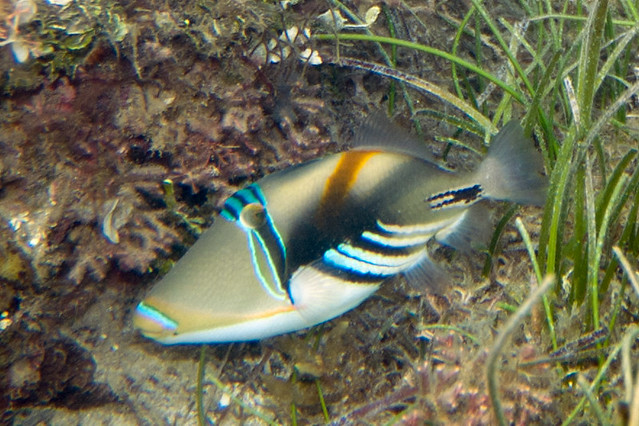 |
| Picasso Triggerfish - Photo by Paul and Jill |
They are nowhere near as expensive as some uncommon species like the clown triggerfish or the expensive crosshatch triggerfish. They range anywhere from $30-$40 depending on the size of the specimen.
They are called the Picasso triggerfish because of the presence of a variety of colored lines across its body. Red, yellow, blue and white lines adorn its face, mouth and the main section of its body. They can attain a length of twelve inches and require larger aquariums with a minimum of 100 gallons because of this.
Like all triggerfish , the Picasso triggerfish has a huge head. Viewed from the side, it makes up to one-third of the total body size. This is a distinctive feature found in all members of the triggerfish family. They are also aggressive and highly territorial and will defend their nesting site against all uninvited guests as many a scuba diver has learned.
, the Picasso triggerfish has a huge head. Viewed from the side, it makes up to one-third of the total body size. This is a distinctive feature found in all members of the triggerfish family. They are also aggressive and highly territorial and will defend their nesting site against all uninvited guests as many a scuba diver has learned.
In the wild, they primarily hunt for crustaceans that include crabs, shrimp and even invertebrates like the sea urchin. They are able to crack the tough exoskeleton of their prey thanks to their immensely powerful jaws. Because of the strength of their jaws, they can deliver painful bites to their human keepers as well.
Because they are carnivores, we must try to mimic their diet in captivity. Offer them meaty foods like freshly chopped seafood that include fish, shrimp, scallops and such. Mysis shrimp, frozen krill and frozen meat mixes are some good choices as well.
Overall, Picasso triggerfish are very hardy and easy to keep provided it has ample swimming space and always be careful to select tank mates that can hold their own against this large and aggressive species.
|

No comments:
Post a Comment